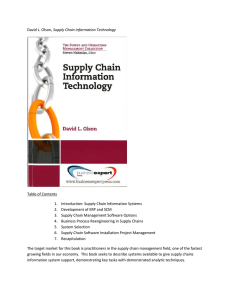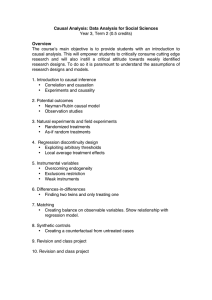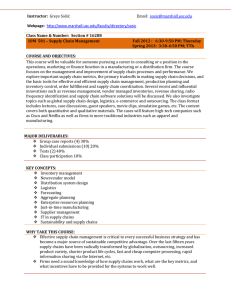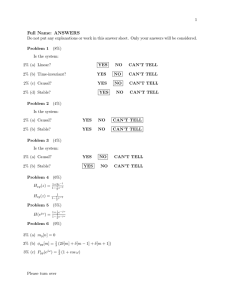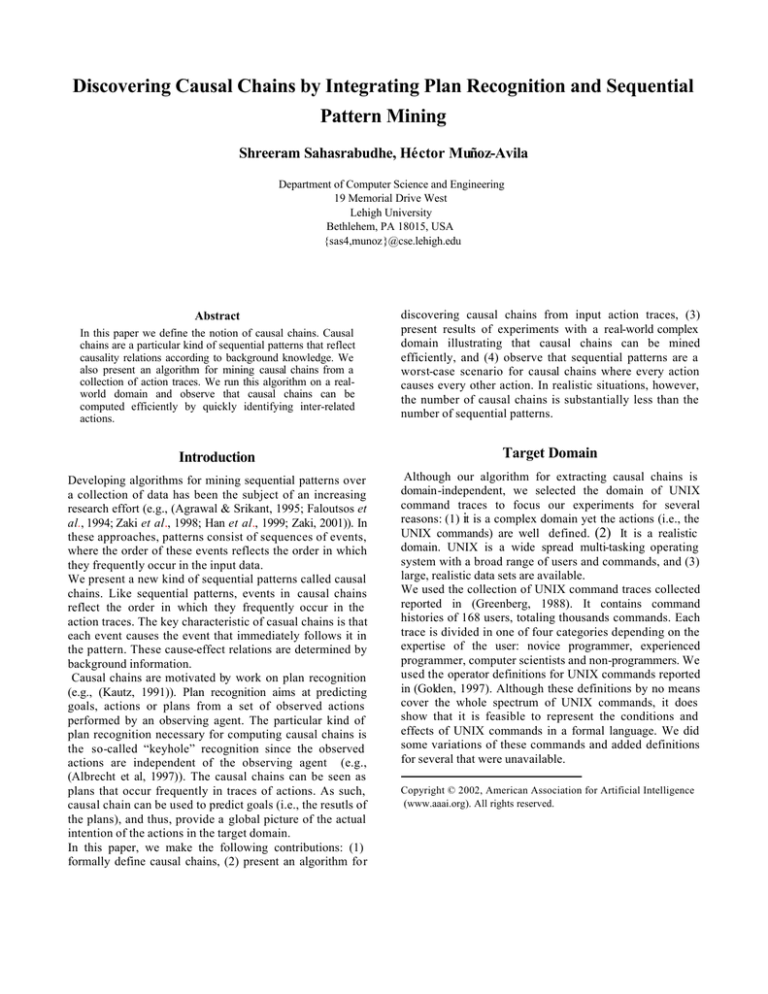
Discovering Causal Chains by Integrating Plan Recognition and Sequential
Pattern Mining
Shreeram Sahasrabudhe, Héctor Muñoz-Avila
Department of Computer Science and Engineering
19 Memorial Drive West
Lehigh University
Bethlehem, PA 18015, USA
{sas4,munoz}@cse.lehigh.edu
In this paper we define the notion of causal chains. Causal
chains are a particular kind of sequential patterns that reflect
causality relations according to background knowledge. We
also present an algorithm for mining causal chains from a
collection of action traces. We run this algorithm on a realworld domain and observe that causal chains can be
computed efficiently by quickly identifying inter-related
actions.
discovering causal chains from input action traces, (3)
present results of experiments with a real-world complex
domain illustrating that causal chains can be mined
efficiently, and (4) observe that sequential patterns are a
worst-case scenario for causal chains where every action
causes every other action. In realistic situations, however,
the number of causal chains is substantially less than the
number of sequential patterns.
Introduction
Target Domain
Developing algorithms for mining sequential patterns over
a collection of data has been the subject of an increasing
research effort (e.g., (Agrawal & Srikant, 1995; Faloutsos et
al., 1994; Zaki et al., 1998; Han et al., 1999; Zaki, 2001)). In
these approaches, patterns consist of sequences of events,
where the order of these events reflects the order in which
they frequently occur in the input data.
We present a new kind of sequential patterns called causal
chains. Like sequential patterns, events in causal chains
reflect the order in which they frequently occur in the
action traces. The key characteristic of casual chains is that
each event causes the event that immediately follows it in
the pattern. These cause-effect relations are determined by
background information.
Causal chains are motivated by work on plan recognition
(e.g., (Kautz, 1991)). Plan recognition aims at predicting
goals, actions or plans from a set of observed actions
performed by an observing agent. The particular kind of
plan recognition necessary for computing causal chains is
the so-called “keyhole” recognition since the observed
actions are independent of the observing agent (e.g.,
(Albrecht et al, 1997)). The causal chains can be seen as
plans that occur frequently in traces of actions. As such,
causal chain can be used to predict goals (i.e., the resutls of
the plans), and thus, provide a global picture of the actual
intention of the actions in the target domain.
In this paper, we make the following contributions: (1)
formally define causal chains, (2) present an algorithm for
Although our algorithm for extracting causal chains is
domain-independent, we selected the domain of UNIX
command traces to focus our experiments for several
reasons: (1) it is a complex domain yet the actions (i.e., the
UNIX commands) are well defined. (2) It is a realistic
domain. UNIX is a wide spread multi-tasking operating
system with a broad range of users and commands, and (3)
large, realistic data sets are available.
We used the collection of UNIX command traces collected
reported in (Greenberg, 1988). It contains command
histories of 168 users, totaling thousands commands. Each
trace is divided in one of four categories depending on the
expertise of the user: novice programmer, experienced
programmer, computer scientists and non-programmers. We
used the operator definitions for UNIX commands reported
in (Golden, 1997). Although these definitions by no means
cover the whole spectrum of UNIX commands, it does
show that it is feasible to represent the conditions and
effects of UNIX commands in a formal language. We did
some variations of these commands and added definitions
for several that were unavailable.
Abstract
Copyright © 2002, American Association for Artificial Intelligence
(www.aaai.org). All rights reserved.
Problem Formulation
Background Knowledge
In our framework the background knowledge is a list of
operators. An operator consists of (1) a name, (2) a list of
arguments, (3) a list of preconditions and (4) a list of effects.
The preconditions are a list of literals indicating the
conditions that must be valid for the operator to be
applicable. The effects are a collection of literals to be
added or deleted; they indicate the changes in the
conditions as a result of applying the operator. Table 1
shows the definition of the operator rm, which indicates the
effects of removing one or more files. The name of each file
is an argument. The preconditions indicate that the
existence of each file. The effect of rm is to delete the
condition about existence of the file . We use brackets in
Table 1 to represent that the number of arguments,
preconditions and effects is not fully known until the
operator is matched against a command in the traces. we
adopted the principles of the SADL language (Golden,
1997). SADL was conceived for expressing actions whose
conditions and effects may only be known during the
execution of the action. We define an action as an instance
of an operator. We view an action trace as an ordered
collection of actions. For the UNIX command traces data,
we refer to the actions as commands
Table 1: Example of the operator rm
Operator: rm
Arguments: [<filename><type = file>]
Precondition:
[<filename><type = file><status = exists>]
Effects:
[<filename><type = file><status = not exists>]
Causal chains
Given a sequence of elements A = (a 1 … an), a subsequence
of k elements in A, (a 1, … ak), is a k-subsequence of A if
each aj occurs before aj+1 in A.
An action trace T = (a 1 … an) supports a sequence of
actions P = (b 1, … b m ) if there is a m-subsequence S = (a 1 …
am ) of T such that there is a mapping from the arguments of
each b j in P to the arguments of each aj in S such that if the
mapping is applied to P, P and S are identical. In this
situation, we say that S is a sequence supporting P.
An action trace (b 1 … bm ) is a Causal chain if:
(b 1 … bm ) is supported by at least a certain predefined
percentage, called the minimum support, of the input
action traces.
The m-subsequence (a 1 … am ) of each supporting action
trace (a 1 … an) meets the following conditions:
At least one of the effects of ai is a literal li that is present in
the preconditions of ai+1.
There is no action ak in the action trace that is clobbering
the literal li linking aj and aj+1 . That is, there is no ak between
aj and aj+1 deleting li.
The first requirement ensures that the Causal chain and
each of its supporting sequences are equivalent
applications of the same operator. It is not sufficient to
require actions in the pattern and the supporting sequences
to be instances of the same operators. The reason is that
operators have a variable number of arguments,
preconditions and effects. Thus, two instances of the same
operator may result in actions that do not match. The next
two conditions ensure the causality relation between the
actions in the Causal chain. In particular, it is crucial that no
actions are clobbering these causality relations. We refer to
the m-subsequence (a 1 … am ) of the definition of Causal
chain as a chain. The requirement for these causality
relations is typical for plan recognition.
Our definition of Causal chain follows the principle for
mining sequential patterns stated in (Agrawal & Srikant,
1995) and others (e.g., (Zaki, 2001)) of counting support
from each trace once even if the same pattern appears more
than once. Also from (Agrawal & Srikant, 1995; Zaki 2001),
we will identify Causal chains that are maximal: A Causal
chain, C, of length k is a maximal if there is no other Causal
chain, C’, of size h, such that C is a k-subsequence of C’
and h > k.
Example of a Causal Chain
Table 2 presents two sample action traces. The first trace
consists of 4 commands: (1) the file thesis is renamed as
thesis.bak, (2) a symbolic link, by the name thesis, is made
to the file thesis contained in the directory docs, (3) the
contents of docs are listed, and (4) the file thesis in the
directory docs (pointed by the symbolic link) is copied into
the file named thesis1. The second trace consists of two
commands: (1) a symbolic link, by the name paper, is made
to the file paper contained in the directory papers, and (2) a
copy of the file paper in the directory papers (pointed by
the symbolic link) is made into the file named paper1.
Table 2: Two samples of action traces
(mv thesis thesis.bak, ln –s docs/thesis, ls docs,
1
cp thesis thesis1)
2
(ln –s papers/paper, cp paper paper1)
If the minimum support is 100%, the only Causal chain is (ln
–s papers/paper, cp paper paper1). This pattern is
supported by the 2-sequence (ln –s docs/thesis, cp thesis
thesis1) of the first trace and the 2-sequence (ln –s
papers/paper, cp paper paper1) of the second trace. The
pattern (ln –s docs/ thesis, cp thesis thesis1) is considered
equivalent to (ln –s papers/paper, cp paper paper1) since
there is the mapping of their arguments, {docs à papers,
thesis à paper, thesis1 à paper1}, making these two
patterns identical.
Table 4: Instantiated operator rm
Algorithm for mining causal chains
1
m
We refer to the m-subsequence (a … a ) of the definition
of Causal chain in Section 3.2 as a chain. A maximal Causal
chain can be seen as a chain that is maximal (i.e., the chain
is not a k-subsequence of another chain with more than k
elements) and that has the minimum required support. The
idea of the algorithm is to follow a bottoms -up process
whereby chains are constructed for each action trace
independently and then chains from different traces are
matched to find those that have the required minimum
support.
The algorithm for mining maximal Causal chains begins by
processing the input action traces to instantiate the
commands with their corresponding operators (Section 4.1).
The next step is where the chains are identified for each
trace (4.2). To improve efficiency and remove redundancy
we perform a cleansing step where equivalent chains are
detected and removed (4.3). Finally, maximal Causal chains
are mined by determining which maximal chains have the
required minimum support (4.4).
Action Traces Instantiation
The data files contain the input action traces. In this phase,
these files are parsed. During parsing, each command is
instantiated with its matching operator to determine the
arguments, preconditions and effects. The output of this
phase, are the traces consisting of the instantiated
operators.
Table 3: Example of a command in input traces
C rm sam
D /user/grads/xxx
A NIL
H NIL
X NIL
Table 3 shows an example of a UNIX command entry in the
input action traces as they appear in (Greenberg, 1988).
Every command is annotated with 5 fields labeled with
initials C, D, A, H and X. The field C corresponds to the
command as typed by the user. In this example the
command type is remove sam (rm sam). D indicates the
current directory where the command was executed
(/user/grads/xxx). A indicates the alias of the command
(NIL indicates that no alias was used). H indicates if the line
was retrieved through history. X indicates if the command
was executed successfully (anything different than NIL
indicates failure). Thus, the reading of the command in
Table 3 is that the file sam was removed from the directory
/user/grads/xxx
Name: rm
---Arguments:--Name: sam; Type: F
---Preconditions:--Name: /user/grads/xxx; Type: P; Status: E
Name: sam; Type: F; Status: E
---Effects:--Name: sam; Type: F; Status: NE
Our program parsing the commands first checks if there is
no error. If no error occurs, we lookup (1) the command
name (e.g. rm), (2) any command options (i.e., labeled by a
- sign following the command name), and (3) the number of
arguments. These three elements determine what the
command is actually doing and how the matching operator
instantiates the command. For example, the move command
(mv) has different effects if called with two arguments than
if called with more than two arguments; when called with
two arguments, the first one is renamed to the second. But
when called with more than two arguments e.g. “mv f1 f2 …
fn d”, the last argument, d, is a directory to which the files
f1 … fn are moved.
The arguments and the directory field (labeled D in Table 3)
are used to instantiate the arguments, preconditions and
effects of the operator. Each instantiated operator is added
to the traces. The traces containing the sequence of
instantiated operators are the output of this phase. Table 4
shows the instantiated operator for the command shown in
Table 3 and the operator shown in Table 1. The label F in
Type indicates that the argument is a file (other possibilities
include D for directory, P for the current path of the user,
SL for soft link). The status can be E meaning that the file
exists or NE meaning that the file does not exists.
An issue in this phase is when parsing commands where no
operator definition is available. A typical example of such a
command is the UNIX command make. This command
executes a script issuing other commands typically used in
connection with compiling pieces of a code. We currently
ignore these commands but we acknowledge that this is a
limitation and intend to address this in the next phase of
our research. One possibility is to assume that any
command for which no operator definition is known can
cause any subsequent command.
Identification of Chains
This phase receives as input traces of instantiated
operators. The goal of this phase is to identify chains for
each trace. For each command, C, we construct what we
called a chain-set for C. The chain-set for a command C, is
the set of all chains that start with C.
We perform this chain identification process for each trace
independently. The basic algorithm for our implementation
is presented below:
1. For each command Cj (1≤ j < N) in the trace we
construct a chain-set, initially consisting of a single 1sequence containing Cj . Then for each Chain Set we
perform Step 2.
2. For each command Nj occurring after Cj (i.e., i+1 ≤ j
≤ N) we perform Steps 3 and 4
3. Compare Nj with the last command L of each chain
CHm in the chain-set of Cj . If any effect e of L is a
precondition of Nj and e is not clobbered between L
and Nj then create a new chain, CHm + Nj , and add it to
the chain-set of Cj .
The algorithm will basically create a chain-set for each
command. We only create chain-sets for new commands
(i.e., there are no two chain-sets for the same command).
Given a trace of instantiated operators, the cause-effect
relations define a partial order between the actions in the
trace. Algorithms have been proposed in the AI planning
literature to compute such partial order for an input plan
(e.g., (Veloso and Carbonell, 1993)). The chain identification
process computes all total ordered subsequences.
Removing Equivalent Chains
In this phase we remove equivalent chains from each of the
k-Chain Sets (1≤ k < N). A chain C = (a 1 … ak) is equivalent
to another chain C’ = (b 1 … bk) if there is a mapping from
the arguments of each ai in C to the arguments of each bi in
C’ such that if the mapping is applied to C, then C and C’
are identical. When an equivalent chain is removed its
predecessor chains are removed as well. The reason for this
is that, any h-subsequence of C (with h < k) must be
equivalent to a h-subsequence of C’.
Determining Support for Maximal Chains
In the final stage of our algorithm, the maximal chains for
the different traces are compared looking for equivalent
chains. If for a given chain (a 1 … an), the required minimum
support is not met, the algorithm tries with the predecessor
chain (a 1 … an-1) and continues until 20 chains (a 1 a2).
We now give a concrete equivalent example of equivalent
chains. Suppose that the following chains from two
different traces are being compared:
mv file1 file2 [pre 1/eff1], cp file2 file3 [pre 2/eff2], rm file3
[pre 3/eff3]
mv file40 file23 [pre 4/eff4], cp file23 file33 [pre 5/eff5], rm
file33 [pre 6/eff6]
Where pre i/effi are the preconditions and effects of each
command according to the background knowledge. For
example:
eff3 = [Name: file3; Type: F; Status: NE; Tag: d]
eff6 =[Name: file33; Type: F; Status: NE; Tag: d]
These two chains are equivalent with the mapping:
{file1 à file40, file2 à file23, file3 à file 33}
Experiment
To evaluate our algorithm for extracting causal chains we
performed experiments with the UNIX user command traces.
The purpose of our experiments was to find all maximal
Causal chains for non synthetic domain.
Sequential Mining
A sequential pattern is a sequence of actions P = (b 1 … bm )
for which a certain predefined percentage of the input
action traces (i.e., the minimum support) meet the following
condition: there is a m-subsequence S = (a 1 … am ) of the
action trace such that the action names, options and the
number of arguments of each b i and ai are the same.
For the experiment we implemented a simple-minded
algorithm for mining sequential patterns that is correct (i.e.,
it finds sequential patterns only) and complete (i.e., it
doesn’t leave out any sequential pattern). The purpose is
to have a baseline for comparing the number of patterns
that can be found with the CES approach.
The algorithm for mining sequential patterns begins with
the action traces instantiation process (See Section 4.1).
But for sequential mining we only take into account the
command names, options and the number of arguments.
That is, we don’t consider the actual arguments, the
preconditions and the effects. The reason is that sequential
patterns are mined without the system having the
background knowledge. Hence, the comparison between
any two sequences is simply done by verifying that they
have the same command name, the same option and the
same number of arguments. We make sure that there are no
repeated sequences. For doing this, we have to check for
an exact match in the arguments.
Table 5: User categories for input traces
Categories
Input
Trace
Action Length
Traces (average)
Computer scientists
17
586.35
Experience
34
691.41
Programmers
Novice Programmers 55
348.90
Non-Programmer
25
472.96
Experimental Setup
The experiments were performed on a single Pentium 4
1.6GHz machine with 512MBytes of RAM. Table 5
summarizes the input action traces used in the experiments.
The first column describes the user categories. The second
column the number of traces for each category and the third
column the average size of the traces (number of
commands).
We ran experiments for computing Causal chains and
sequential patterns for each of the four user categories. For
each run we computed the number of maximal Causal chains
and sequential patterns. We ran the experiments for
support percentages of 100, 70, 40 and 10, for a total of 16
runs.
chains for each trace independently and then comparing
the chains seem to have worked well for this particular
input data. In this data (see Table 6), there are relatively few
traces considered in each run (up 20) but the traces
contained a large number of commands (up to 691).
Experienced Programmers
10
40
70
100
10
1
Support (Percentage)
CES
Figure 2: Results for experienced programmers
Novice Programmers
1000000
100000
10000
1000
100
10
CES
10
40
70
1
Sequence
10000
1000
100
Support (Percentage)
Figure 3: Results for novice programmers
10
40
70
10
1
Sequence
10000
1000
100
100
1000000
100000
100
Number of Patterns
Computer Scientists
1000000
100000
Sequence
Number of Patterns
The readings for mining sequential patterns were taken for
a 1-hour run because of the combinatorial factor would
require too much time and resources to compute all
sequential patterns. We also mined the Causal chains first.
Thus, we knew the length of the maximal patterns for each
user category. When running the sequential mining
approach we stopped the sequential pattern mining process
when we reached sequences of length larger than the
length of the maximal Causal chain length. In most runs
however, we reach the 1-hour limit before being able to
compute all sequence patterns of the maximal length. Thus,
the total number of sequential patterns computed is a lower
bound for the total number of possible sequential patterns.
Number of Patterns
Users / Support (%)
100
70
40
10
Computer Scientists
31
29
28
26
Experience
90
80
77
64
Programmers
Novice Programmer
70
68
65
55
Non-Programmer
40
38
37
33
Table 6: Time (in seconds) for finding the causal chains
Support (Percentage)
CES
Figure 1: Results for computer scientists
Results
Table 6 shows the run times for the different users and
support percentages for mining Causal chains. The support
percentages, 100, 70, 40 and 10, are spaced to cover a wide
support range. Despite that we didn’t emphasize efficiency
in our implementation of the algorithm for mining Causal
chains, the time that it took for each run was relatively low
for the hardware we used and the size of the input data. The
worst time was 1.5 minutes but more than half of the runs
took less than a minute. Our strategy of constructing
Figures 1-4 show the total number of Causal chains found
for each of the four user categories on the logarithmic scale.
These figures also show the number of sequential patterns
for the same input data and support. As explained before,
the sequential patterns found is a subset of the sequential
patterns that can potentially be mined from this data. Still,
from these readings we observe that the number of Causal
chains is substantially less than the number of sequential
patterns. Sequential patterns are a worst-case scenario for
Causal chains where every action can cause another action.
As expected, the number of Causal chains is several orders
of magnitude less than the number of sequential patterns
for this domain. This illustrates that is feasible to learn all
Causal chains even for very large data sets. The crucial
point being that non relevant data from the point of view of
the cause-effect relationships can be quickly discarded
allowing the learning algorithms to concentrate on interrelated actions.
Number of Patterns
Non-Programmers
1000000
100000
10000
1000
100
10
CES
10
40
70
100
1
Sequence
Support (Percentage)
Figure 4: Results for non-programmers
Discussion and Final Remarks
Sequential patterns are a worst-case scenario for Causal
chains where every action can cause another action. In our
experiments, the number of Causal chains is several orders
of magnitude less than the number of sequential patterns.
Mining causal chains is motivated by plan recognition work
where the aim is to predict goals. In a collection of traces,
the goals are the effects of the causal chains. We saw that
even for a real-world domain such as UNIX command traces,
the number of chains generated is relatively small. Thus,
they provide a global picture of the actual intend (i.e., all of
the resulting goals) of the traces.
Mining Causal chains can have important applications.
Particularly, Causal chains can be used to find patterns
from a collection of intrusion logs. These patterns can be
used to detect security flaws in a system. Since Causal
chains describe structural patterns reflecting causal
relations, inter-related actions can be rapidly identified. As
a result, Causal chains can be computed efficiently for large
collections of input data.
References
Agrawal, R. Srikant, R. Mining Sequential Patterns. In
Proceedings of the International Conference on Data
Engineering, 1995
Albrecht, D. W., Zukerman, I., Nicholson, A. and Bud, A.,
Towards a Bayesian Model for Keyhole Plan Recognition
in Large Domains, Proceedings of the 6th International
Conference on User Modelling, 1997, pp. 365-376.
Chien, S.A; Hill, R.W; Wang, X; Estlin, T; Fayyad, K.V. &
Mortenson, H.B. (1996) Why Real-world Planning is
Difficult: a Tale of Two Applications. In: New Directions
in AI Planning, M.Ghallab & A.Milani, eds, IOS Press,
Washington DC 1996 pp 287-98
Davison, B., and Hirsch, H. (1998). Predicting sequences of
user actions. In Notes of the AAAI/ICML 1998
Workshop on Predicting the Future: AI Approaches to
Time-Series Analysis.
Faloutsos, V., Ranganathan, M. and Manolopoulos, Y.
"Fast Subsequence Matching in Time-Series Databases".
Proc. ACM SIGMOD, May 25-27, 1994, Minneapolis, MN.
pp. 419-429
Fikes, R. E., Hart, P. E., and Nilsson, N. J. Learning and
executing generalized robot plans. Artificial Intelligence,
3:251-288, 1972..
Golden, K. 1997. Planning and Knowledge Representation
for Softbots. Ph.D. Dissertation, University of
Washington. Available as UW CSE Tech Report 97-11-05.
Han, J., Yang, Y., and Kim, K. Plan Mining by Divide and
Conquer. In Proceedings of the 1999 SIGMOD Workshop
on Data Mining. Philidelphia, PA. June 1999.
Kautz., H., A Formal Theory of Plan Recognition and its
Implementation, Reasoning About Plans, Allen, J.,
Pelavin, R. and Tenenberg, J. ed., Morgan Kaufmann, San
Mateo, C.A., 1991, pp. 69-125.
Korvemaker, B. and Greiner, R. Predicting UNIX command
lines: Adjusting to user patterns. In Adaptive User
Interfaces: Papers from the 2000 AAAI Spring
Symposium, pages 59-64, 2000
Mannila, H., Toivonen, H., and Verkamo, A.I. "Discovery of
frequent episodes in sequences" First International
Conference on Knowledge Discovery and Data Mining
(KDD'95) 210 - 215, Montreal, Canada, August 1995.
Martelli, A. and Montanari, U. "An Efficient Unification
Algorithm". ACM Transactions on Programming
Languages
and
Systems,
Vol.
4,
No.
2
(April 1982), pp. 258-282.
Veloso, M.M., Carbonell, J.G. Derivational analogy in
PRODIGY: Automating case acquisition, storage, and
utilization, Machine Learning, 10:249-278, 1993.
Zaki, M. J., Lesh, N., & Ogihara M. PLANMINE: Sequence
Mining for Plan Failures. In: Proceedings of the Fourth
International Conference on Knowledge Discovery and
Data Mining (KDD'98), 1998
Zaki, M.J., SPADE: An Efficient Algorithm for Mining
Freque

